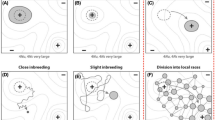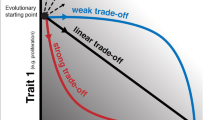Abstract
Preserving a system’s viability in the presence of diversity erosion is critical if the goal is to sustainably support biodiversity. Reduction in population heterogeneity, whether inter- or intraspecies, may increase population fragility, either decreasing its ability to adapt effectively to environmental changes or facilitating the survival and success of ordinarily rare phenotypes. The latter may result in over-representation of individuals who may participate in resource utilization patterns that can lead to over-exploitation, exhaustion, and, ultimately, collapse of both the resource and the population that depends on it. Here, we aim to identify regimes that can signal whether a consumer–resource system is capable of supporting viable degrees of heterogeneity. The framework used here is an expansion of a previously introduced consumer–resource type system of a population of individuals classified by their resource consumption. Application of the Reduction Theorem to the system enables us to evaluate the health of the system through tracking both the mean value of the parameter of resource (over)consumption, and the population variance, as both change over time. The article concludes with a discussion that highlights applicability of the proposed system to investigation of systems that are affected by particularly devastating overly adapted populations, namely cancerous cells. Potential intervention approaches for system management are discussed in the context of cancer therapies.




Similar content being viewed by others
References
Brauer F, Castillo-Chavez C (2012) Mathematical models in population biology and epidemiology. Springer, Berlin
Brauer F, Castillo-Chavez C (2013) Mathematical models for communicable diseases. SIAM, Philadelphia
Burrell RA, McGranahan N, Bartek J, Swanton C (2013) The causes and consequences of genetic heterogeneity in cancer evolution. Nature 501(7467):338–345
Carpenter S, Walker B, Anderies JM, Abel N (2001) From metaphor to measurement: resilience of what to what? Ecosystems 4(8):765–781
Castillo-Chavez C (2013) The control, dynamics and evolution of emergent and re-emergent diseases in the context of sustainability. http://www.mathaware.org/mam/2013/essays/
Castillo-Chavez C, Levin SA, Gould F (1988) Physiological and behavioral adaptation to varying environments: a mathematical model. Evolution 42(5):986–994
Chow K, Wang X, Curtiss R III, Castillo-Chavez C (2011) Evaluating the efficacy of antimicrobial cycling programmes and patient isolation on dual resistance in hospitals. J Biol Dyn 5(1):27–43
Crow JF, Kimura M (1970) Introduction to Population Genetics Theory. Harper & Row, New York
Darwin C (1859) On the origin of species by means of natural selection, or, the preservation of favoured races in the struggle for life. J. Murray
Davies J, Davies D (2010) Origins and evolution of antibiotic resistance. Microbiol Mol Biol Rev 74(3):417–433
DeBerardinis RJ, Cheng T (2009) Q’s next: the diverse functions of glutamine in metabolism, cell biology and cancer. Oncogene 29(3):313–324
Denholm I, Rowland MW (1992) Tactics for managing pesticide resistance in arthropods: theory and practice. Annu Rev Entomol 37(1):91–112
Dwyer G, Levin SA, Buttel L (1990) A simulation model of the population dynamics and evolution of myxomatosis. Ecol Monogr 60:423–447
Elser JJ, Kyle MM, Smith MS, Nagy JD (2007) Biological stoichiometry in human cancer. PloS One 2(10):e1028
Fenichel EP, Castillo-Chavez C, Ceddia MG, Chowell G, Parra PAG, Hickling GJ, Holloway G, Horan R, Morin B, Perrings C et al (2011) Adaptive human behavior in epidemiological models. Proc Natl Acad Sci 108(15):6306
Fisher RA (1999) The genetical theory of natural selection: a complete variorum edition. Oxford University Press, Oxford
Gatenby RA, Silva Ariosto S (2009) Adaptive therapy. Cancer Res 69(11):4894–4903
Gillies RJ, Robey I, Gatenby RA (2008) Causes and consequences of increased glucose metabolism of cancers. J Nucl Med 49(Suppl 2):24S–42S
Gladwell M (2000) The tipping point: how little things can make a big diflerence. Little, Brown, Boston
Gorban AN, Smirnova EV, Tyukina TA (2010) Correlations, risk and crisis: from physiology to finance. Phys A Stat Mech Appl 389(16):3193–3217
Hahnfeldt P, Folkman J, Hlatky L (2003) Minimizing long-term tumor burden: the logic for metronomic chemotherapeutic dosing and its antiangiogenic basis. J Theor Biol 220(4):545–554
Hiebeler DE, Morin BR (2007) The effect of static and dynamic spatially structured disturbances on a locally dispersing population. J Theor Biol 246(1):136–144
Hooper DU, Chapin Iii FS, Ewel JJ, Hector A, Inchausti P, Lavorel S, Lawton JH, Lodge DM, Loreau M, Naeem S et al (2005) Effects of biodiversity on ecosystem functioning: a consensus of current knowledge. Ecol Monogr 75(1):3–35
Janssen Marco A, Anderies John M (2007) Robustness trade-offs in social-ecological systems. Int J commons 1(1):43–66
Karev GP (2010) On mathematical theory of selection: continuous time population dynamics. J Math Biol 60(1):107–129
Kareva I (2011) What can ecology teach us about cancer? Transl Oncol 4(5):266
Kareva I, Berezovskaya F, Castillo-Chavez C (2012) Transitional regimes as early warning signals in resource dependent competition models. Math Biosci 240(2):114–123
Kareva I, Morin B, Karev GP (2013) Preventing the tragedy of the commons through punishment of over consumers and encouragement of under-consumers. Bull Math Biol 75(4):565–588
Kareva I (2013) Biological stoichiometry in tumor micro-environments. PloS One 8(1):e51844
Kerbel RS, Klement G, Pritchard KI, Kamen B (2002) Continuous low-dose anti-angiogenic/metronomic chemotherapy: from the research laboratory into the oncology clinic. Ann Oncol 13(1):12–15
Kermark MD, Mckendrick AG (1927) Contributions to the mathematical theory of epidemics. Part i. In: Proceedings of the Royal Society A, vol 115, pp 700–721
Krakauer DC, Page KM, Erwin DH (2009) Diversity, dilemmas, and monopolies of niche construction. Am Nat 173(1):26–40
Laurance J (2012) Health chief warns: age of safe medicine is ending. The Independent. http://www.independent.co.uk/life-style/health-and-families/health-news/health-chief-warns-age-of-safe-medicine-is-ending-7574579.html
Levin S, Castillo-Chavez C (1990) Topics in evolutionary ecology. In: Mathematical and statistical developments of evolutionary theory. Springer Netherlands, Chicago, pp 327–358
Lewontin RC (1970) The units of selection. Annu Rev Ecol Syst 1:1–18
Lipsitch M, Cohen T, Murray M, Levin BR (2007) Antiviral resistance and the control of pandemic influenza. PLoS Med 4(1):e15
McCarthy M (2013) 800 samples showed antibiotic resistance last year, says agency as it backs Chief Medical Officer’s warning. The Independent. http://www.independent.co.uk/news/science/800-samples-showed-antibiotic-resistance-last-year-says-agency-as-it-backs-chief-medical-officers-warning-8530086.html
Meyer GA, Root RB (1996) Influence of feeding guild on insect response to host plant fertilization. Ecol Entomol 21(3):270–278
Morin BR, Fenichel EP, Castillo-Chavez C (2013) SIR dynamics with economically driven contact rates. Nat Resour Model 26(4):505–525
Muneepeerakul R, Qubbaj MR, Aggarwal RM, Anderies JM, Janssen MA (2012) Critical transition between cohesive and population-dividing responses to change. J R Soc Interface 9(77):3303–3311
Ostrom E (1990) Governing the commons: the evolution of institutions for collective action. Cambridge University Press, Cambridge
Pasquier E, Kavallaris M, André N (2010) Metronomic chemotherapy: new rationale for new directions. Nat Rev Clin Oncol 7(8):455–465
Pianka ER (1970) On r- and K-selection. Am Nat 104(940):592–597
Rankin DJ, López-Sepulcre A (2005) Can adaptation lead to extinction? Oikos 111(3):616–619
Rodriguez Armando A, Oguzhan Cifdaloz, Martin Anderies John, Jeffrey Dickeson (2011) Confronting management challenges in highly uncertain natural resource systems: a robustness-vulnerability trade-off approach. Environ Model Assess 16(1):15–36
Root BR (1965) The guild concept and community analysis. Bull Ecol Soc Am 46:177
Root BR (2001) The guild concept. In: Levin SA (ed) Encyclopedia of Biodiversity. Academic Press, San Diego, pp 295–302
Rosenberg SA, Hellman S, DeVita VT (2005) Cancer: principles and practice of oncology. Lippincott Williams & Wilkins, Philadelphia
Simberloff D, Dayan T (1991) The guild concept and the structure of ecological communities. Annu Rev Ecol Syst 22:115–143
Smith AT, Foggin JM (1999) The plateau pika (Ochotona curzoniae) is a keystone species for biodiversity on the Tibetan plateau. Anim Conserv 2(4):235–240
Tilman D, May RM, Lehman CL, Nowak MA (1994) Habitat destruction and the extinction debt. Nature 371:65–65
Vermeulen K, Van Bockstaele DR, Berneman ZN (2003) The cell cycle: a review of regulation, deregulation and therapeutic targets in cancer. Cell Prolif 36(3):131–149
Acknowledgments
This work has been partially supported by Grants from the National Science Foundation (NSF-Grant DMPS-0838705), the National Security Agency (NSA-Grant H98230-09-1-0104), the Alfred P. Sloan Foundation, the Office of the Provost of Arizona State University and Intramural Research Program of the NIH, NCBI. This publication was made possible in part by Grant No. 1R01GM100471-01 from the National Institute of General Medical Sciences (NIGMS) at the National Institutes of Health. Its contents are solely the responsibility of the authors and do not necessarily represent the official views of NIGMS.
Author information
Authors and Affiliations
Corresponding author
Rights and permissions
About this article
Cite this article
Kareva, I., Morin, B. & Castillo-Chavez, C. Resource Consumption, Sustainability, and Cancer. Bull Math Biol 77, 319–338 (2015). https://doi.org/10.1007/s11538-014-9983-1
Received:
Accepted:
Published:
Issue Date:
DOI: https://doi.org/10.1007/s11538-014-9983-1




